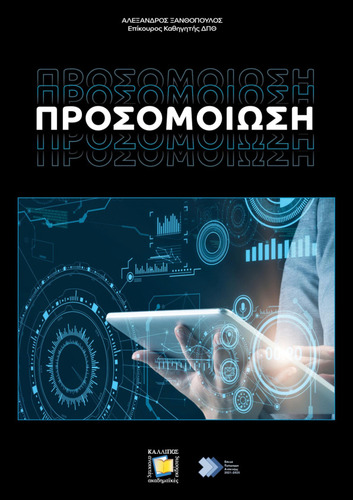| Title Details: | |
|
Simulation |
|
| Authors: |
Xanthopoulos, Alexandros |
| Reviewer: |
Koulouriotis, Dimitrios |
| Subject: | MATHEMATICS AND COMPUTER SCIENCE > COMPUTER SCIENCE > COMPUTATIONAL SCIENCE > INTRODUCTION TO MODELING AND SIMULATION MATHEMATICS AND COMPUTER SCIENCE > COMPUTER SCIENCE > COMPUTATIONAL SCIENCE > MODELING AND SIMULATION MATHEMATICS AND COMPUTER SCIENCE > COMPUTER SCIENCE > PROGRAMMING LANGUAGES > OBJECT-ORIENTED PROGRAMMING ENGINEERING AND TECHNOLOGY > TECHNOLOGICAL SCIENCES AND ENGINEERING > INDUSTRIAL TECHNOLOGY AND ENGINEERING > MANUFACTURING SYSTEMS MATHEMATICS AND COMPUTER SCIENCE > MATHEMATICS > STATISTICS MATHEMATICS AND COMPUTER SCIENCE > MATHEMATICS > STATISTICS > DESIGN OF EXPERIMENTS MATHEMATICS AND COMPUTER SCIENCE > MATHEMATICS > NUMERICAL ANALYSIS > MATHEMATICAL PROGRAMMING, OPTIMIZATION AND VARIATIONAL TECHNIQUES |
| Keywords: |
Simulation
System Modelling System dynamics Discrete event simulation Multi agent simulation Object oriented programming Simulation software Experiment Probability distribution Analysis of variance Regression analysis Optimization Design of experiments Evolutionary algorithms |
| Description: | |
| Abstract: |
The book consists of three parts which answer the fundamental questions of this specific scientific field: a) What is the theory behind a simulation? b) How do we implement a simulator? c) How do we use the simulations and the results they give us? The first part of the book (Chapters 1 and 2) "builds" the necessary theoretical background for designing and implementing simulation studies. The second part of the book (chapters 3-8) studies the core of this scientific field which is no other than the implementation of simulators itself. We study 24 short programs written in C++ and 13 simulator implementations in the C++ language and the JaamSim software of JaamSim Software Inc. (https://jaamsim.com/). The simulators concern, among others, production, inventory, service and queuing systems. All applications are freely available to readers who may cite this book as a bibliographical source (see licensing page at the beginning of the book). The third part of the book (Chapters 9 and 10) addresses the topics that come after a simulator implementation. In chapter 9 we study how to set up/run simulation experiments and how to analyze the numerical results. In chapter 10 we discuss key issues related to optimization in simulation applications.
|
| Linguistic Editors: |
Kalliaras, Dimitrios |
| Graphic Editors: |
Papavasiliou, Spiridon |
| Type: |
Undergraduate textbook |
| Creation Date: | 23-11-2023 |
| Item Details: | |
| ISBN |
978-618-228-152-9 |
| License: |
Attribution - NonCommercial - ShareAlike 4.0 International (CC BY-NC-SA 4.0) |
| DOI | http://dx.doi.org/10.57713/kallipos-386 |
| Handle | http://hdl.handle.net/11419/11509 |
| Bibliographic Reference: | Xanthopoulos, A. (2023). Simulation [Undergraduate textbook]. Kallipos, Open Academic Editions. https://dx.doi.org/10.57713/kallipos-386 |
| Language: |
Greek |
| Consists of: |
1. Introduction to simulation 2. Discrete Event Simulation 3. Overview of C++ programming language 4. Implementing basic simulation models in C++ 5. Implementing advanced simulation models in C++ 6. Overview of JaamSim simulation software 7. Implementing basic discrete event simulators with the process oriented approach 8. Implementing advanced discrete event simulators with the process oriented approach 9. Configuration, execution and analysis of simulation experiments 10. Optimization Additional Material |
| Number of pages |
338 |
| Publication Origin: |
Kallipos, Open Academic Editions |
| You can also view | |
| User comments | |
There are no published comments available! | |

